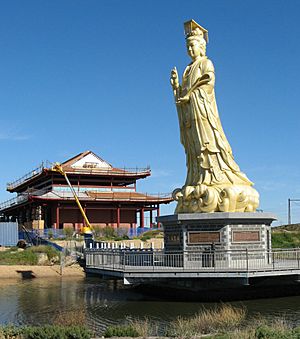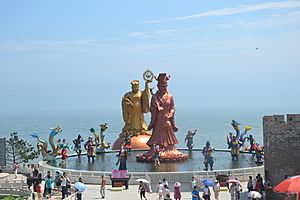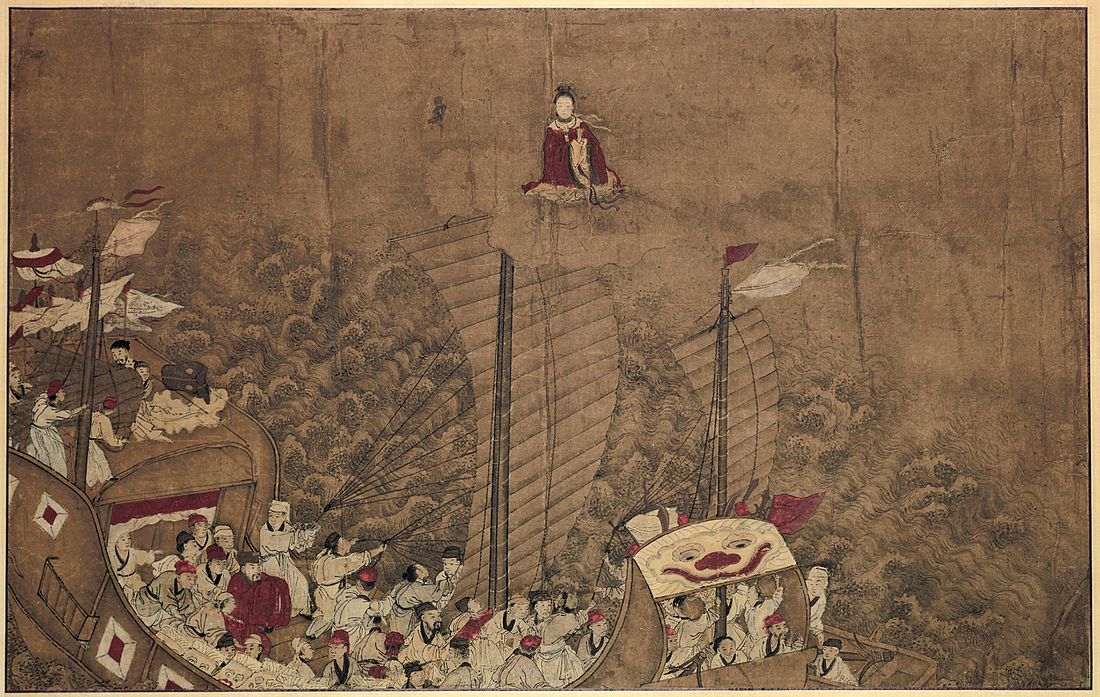Mazu facts for kids
Quick facts for kids Mazu |
|||||||||||||||||||||||||
|---|---|---|---|---|---|---|---|---|---|---|---|---|---|---|---|---|---|---|---|---|---|---|---|---|---|
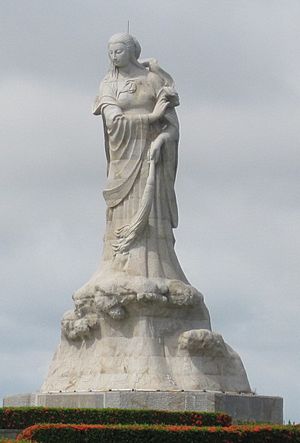
Statue at Lin Moniang Park in Tainan
|
|||||||||||||||||||||||||
| Traditional Chinese | 媽祖 | ||||||||||||||||||||||||
| Simplified Chinese | 妈祖 | ||||||||||||||||||||||||
| Literal meaning | Maternal Ancestor | ||||||||||||||||||||||||
|
|||||||||||||||||||||||||
| Lin Moniang | |||||||||||||||||||||||||
| Traditional Chinese | 林默娘 | ||||||||||||||||||||||||
| Simplified Chinese | 林默娘 | ||||||||||||||||||||||||
|
|||||||||||||||||||||||||
| Popular names | |||||||||||||||||||||||||
|---|---|---|---|---|---|---|---|---|---|---|---|---|---|---|---|---|---|---|---|---|---|---|---|---|---|
| Granny Mazu | |||||||||||||||||||||||||
| Traditional Chinese | 媽祖婆 | ||||||||||||||||||||||||
| Simplified Chinese | 妈祖婆 | ||||||||||||||||||||||||
| Literal meaning | Granny Mazu | ||||||||||||||||||||||||
|
|||||||||||||||||||||||||
| Queen of Heaven | |||||||||||||||||||||||||
| Chinese | 天后 | ||||||||||||||||||||||||
| Literal meaning | Celestial Empress | ||||||||||||||||||||||||
|
|||||||||||||||||||||||||
| Heavenly Consort | |||||||||||||||||||||||||
| Chinese | 天妃 | ||||||||||||||||||||||||
| Literal meaning | Celestial Concubine | ||||||||||||||||||||||||
|
|||||||||||||||||||||||||
| Holy Heavenly Mother | |||||||||||||||||||||||||
| Traditional Chinese | 天上聖母 | ||||||||||||||||||||||||
| Simplified Chinese | 天上圣母 | ||||||||||||||||||||||||
| Literal meaning | Heavenly-&-Sacred Mother | ||||||||||||||||||||||||
|
|||||||||||||||||||||||||
| Formal titles | |||||||||||||||||||||||||
|---|---|---|---|---|---|---|---|---|---|---|---|---|---|---|---|---|---|---|---|---|---|---|---|---|---|
| Lady of Numinous Grace | |||||||||||||||||||||||||
| Traditional Chinese | 靈惠夫人 | ||||||||||||||||||||||||
| Simplified Chinese | 灵惠夫人 | ||||||||||||||||||||||||
| Literal meaning | Powerful-&-Kind Lady | ||||||||||||||||||||||||
|
|||||||||||||||||||||||||
| Consort of Numinous Grace | |||||||||||||||||||||||||
| Traditional Chinese | 靈惠妃 | ||||||||||||||||||||||||
| Simplified Chinese | 灵惠妃 | ||||||||||||||||||||||||
| Literal meaning | Powerful-&-Kind Concubine | ||||||||||||||||||||||||
|
|||||||||||||||||||||||||
| Illuminating Consort of Heaven who Protects the Nation | |||||||||||||||||||||||||
| Traditional Chinese | 護國明著天妃 | ||||||||||||||||||||||||
| Simplified Chinese | 护国明着天妃 | ||||||||||||||||||||||||
| Literal meaning | Nation-protecting Brightly-Burning Celestial Concubine | ||||||||||||||||||||||||
|
|||||||||||||||||||||||||
| Holy Consort of Clear Piety, Pure Faith, and Helpful Response | |||||||||||||||||||||||||
| Traditional Chinese | 昭孝純正孚濟感應聖妃 | ||||||||||||||||||||||||
| Simplified Chinese | 昭孝纯正孚济感应圣妃 | ||||||||||||||||||||||||
| Literal meaning | Clearly Filial and Purely Believing and Helpfully Responding Sacred Concubine | ||||||||||||||||||||||||
|
|||||||||||||||||||||||||
Mazu (pronounced Mah-zoo) or Matsu is a special Chinese sea goddess. People also know her by many other names and titles. She is believed to be a real person named Lin Mo or Lin Moniang who became a goddess.
Lin Moniang was a Fujianese shamaness (a person who connects with spirits). She lived from about 960 to 987 AD. After she died, people honored her as a protector of seafarers, like fishermen and sailors. Her worship spread across China's coastal areas and to Chinese communities around the world, especially in Southeast Asia.
People believed Mazu could travel the seas and protect her followers with amazing help. Today, many people see her as a powerful and kind Queen of Heaven. Mazu worship is very popular in Taiwan. This is because many early settlers in Taiwan were Hoklo people who brought her worship with them. Her temple festival is a huge event in Taiwan, with the biggest celebrations at temples in Dajia and Beigang.
Understanding Mazu's Names and Titles
Mazu is known by many names, each with a special meaning. Her most common name, Mazu or Ma-tsu, means "Maternal Ancestor," "Mother," "Granny," or "Grandmother." Lin Moniang is also called:
- Mazupo ("Granny Mazu") or Ma Cho Po: This is a popular name in Fujian, China.
- A-Ma or Ah-Ma: This means "Mother" or "Grandmother" and is popular in Macau.
- Linghui Furen ("Lady of Numinous Grace"): An official title given to her in 1156.
- Linghui Fei ("Princess of Numinous Grace"): Another official title, given in 1192.
- Tianfei ("Princess of Heaven"): A very important official title given in 1281. It means "Illuminating Princess of Heaven who Protects the Nation."
- Tianhou or Tianhou Shengmu ("Queen/Empress of Heaven"): This title is often used in Mainland China, Hong Kong, and Vietnam. It became an official title in 1683.
- Tianshang Shengmu ("Holy Heavenly Mother"): This title is mostly used in Taiwan.
Even though Mazu has many formal titles like Tianhou and Tianfei, people usually pray to her as Mazu during emergencies. They believe she would take time to get ready if they used her formal titles. Calling her Mazu means she might answer their prayers faster!
Mazu's Life Story
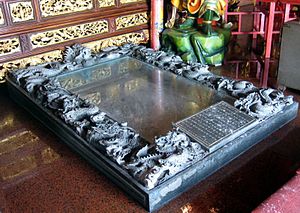
We don't know many exact details about the real Lin Moniang. She was likely a shamaness from a small fishing village on Meizhou Island in Fujian, China, in the late 900s. She might have lived on the nearby mainland instead.
The earliest records of her worship come from about 200 years after she lived. An inscription from 1150 says she "could foretell a man's good and ill luck." It also mentions that "after her death, the people built a temple for her on her home island."
Amazing Legends of Mazu
Stories about Lin Moniang's life became very popular by the 1100s. These legends tell us about her special birth and powers.
Her Birth and Early Life
Mazu was said to be born in 960 AD, during the Song Dynasty. Some older stories say she was born much earlier, in 742. Her given name was Mo ("Silent One") or Moniang ("the Silent Girl"). People said she didn't cry when she was born or for her first month. She was a quiet and thoughtful child.
Legends say her parents prayed for a son but received Mazu instead. In one story, her mother dreamed of the goddess Guanyin giving her a magic pill. Mazu was then born in a flash of red light! Some stories say Mazu was very devoted to Guanyin.
Mazu was said to be very smart. She reportedly mastered important books by age 8 and Buddhist teachings by age 11. A Taoist master supposedly visited her when she was young. He recognized her special nature and left her a book of wisdom. By age 13, she had learned from this book. She gained powers like seeing the future and traveling in spirit. She could also appear in different places without physically going there.
Her Special Powers
Even though she started swimming late, at 15, she became very good at it. She was known for standing on the shore in a red dress, guiding fishing boats home even in bad weather. At 16, she met a Taoist immortal who gave her a special amulet. She used this to help people by healing the sick and stopping disasters. She was also said to be able to make it rain during droughts.
Saving Her Family at Sea
One of Mazu's most famous legends tells how she saved her family during a typhoon when she was 16. In one version, she fell into a trance while weaving. Her spirit went out to sea to save her father and brother from drowning. But her mother woke her up, and she accidentally dropped her brother's spirit, so he was lost at sea. Her father returned and told everyone about the miracle.
Other versions of the story exist. In some, all the men returned safely. In others, she saved three of her four brothers, but the eldest was lost because her parents woke her from her trance.
Her Ascension to Heaven
Earlier records say Mazu died unmarried at 27 or 28. Some stories say she died while meditating. Others say she didn't die but went up to Heaven as a goddess in a bright beam of light from a mountain. Another story says she died at 16, after trying to find her lost father. Her body then washed ashore on Nangan Island, where a tomb is said to be hers.
Myths and Divine Stories
Besides stories about her life, Mazu also appears in many Chinese myths.
Qianliyan and Shunfeng'er
In one myth, two demons, Qianliyan ("Thousand-Mile Eye") and Shunfeng'er ("Wind-Following Ear"), both fell in love with Mazu. She told them she would marry the one who could beat her in a fight. Mazu used her martial arts skills to defeat them both. After that, they became her friends and her special guardian generals.
The Jade Woman of Marvelous Deeds
Another story says Mazu was once the Jade Woman of Marvelous Deeds, a star from the Big Dipper. She was sent to Earth by Laojun, a divine form of Laozi, to help people lost at sea. As Mazu, she promised to protect sailors and help anyone who called on her.
Mazu's Lasting Influence and Worship
How Mazu is Worshipped
Mazuism is the worship of Mazu. It was first mentioned in a poem around 1140. This poem described her followers dancing and singing. An inscription from 1150 said people built a temple for her after she died. In 1086, a temple was built after people saw a glowing light and a vision of "the goddess of Meizhou." This temple was later renamed the Smooth Crossing Temple in 1123. This happened after an official named Lu Yundi was saved by Mazu during a storm at sea.
Mazu's worship grew steadily. By the 1200s, many towns and villages had shrines to her. By the end of the Song dynasty, there were at least 31 Mazu temples, reaching as far north as Shanghai and as far south as Guangzhou.
Mazu's worship also took in beliefs from other local goddesses. She became a protector against drought, floods, sickness, and even pirates. She also helped women during childbirth and with having children. As the protector of the seas, her temples were often the first ones built by Chinese people arriving in new lands. They built them to thank her for their safe journey.
The famous explorer Zheng He, who sailed the seas for the Ming Dynasty, believed Mazu protected one of his journeys. Because of this, she received a new title in 1409. He also helped build a large Mazu temple in Nanjing.
During a war in the 1600s, Mazu was believed to have helped an army capture Taiwan from the Dutch. Later, she was said to have helped another general defeat his enemies in 1683, which brought Taiwan under Chinese control. A prince's palace in Tainan was even turned into the Grand Matsu Temple, the first to use her new title "Heavenly Empress."
In the past, sailors often carried small statues of Mazu to keep them safe at sea. Some boats still have small shrines on their bows today. Mazu charms were also used as medicine. In the 1800s, the government believed Mazu helped them win a battle against the French. During World War II, people believed Mazu protected Taiwan from bombs.
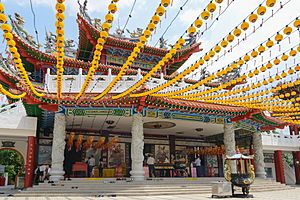
Today, there are about 1500 Mazu temples in 26 countries. Most are in places with many Chinese people, like the Philippines. Almost 1000 of these temples are in Taiwan. In Mainland China, Mazu worship is allowed but not strongly encouraged. Many temples are now like museums.
Since the early 2000s, people from Taiwan can visit Mazu temples in Fujian, China. The A-Ma Temple on Macao Island is likely where Macau got its name. The historic Tin Hau Temple, Causeway Bay in Hong Kong gave its name to the Tin Hau area. The Mazu temple in Melbourne, Australia, is the largest Chinese temple there.
There was a plan to build the world's tallest Mazu statue in Borneo, but it was canceled. The current tallest statue of Mazu is 42.3-meter (139 ft) tall and is located in Tianjin, China.
Important places for Mazu followers to visit include Meizhou Island and the Zhenlan Temple in Taiwan. Xianliang Temple in Putian is also very sacred. A special ceremony is held there every October to remember Mazu's legendary death on the seashore of Xianliang Harbor.
Pilgrimages and Festivals
The main festival for Mazu is her traditional birthday, which falls on the 23rd day of the 3rd month of the Chinese lunar calendar. In Taiwan, two huge pilgrimages happen for her: the Dajia Mazu Pilgrimage and the Baishatun Mazu Pilgrimage. During these festivals, people walk over 300 kilometers, carrying special chairs with Mazu statues between temples. Another big festival is at the Tianhou Temple in Lukang. Mazu's birthday can be in mid-April or mid-May, depending on the year.
People also celebrate the day she died or went to Heaven. This is usually on the Double Ninth Festival, which is the ninth day of the ninth month of the lunar calendar.
Mazu and Unity
Sometimes, Mazu is used to help promote unity among Chinese people. Leaders have encouraged using Mazu's story to bring people together. This is because Mazu is a beloved figure in Chinese culture.
Mazu in Art and Media
After her death, Mazu was often shown as a young lady in a red dress, traveling over the seas. In statues, she usually wears the clothes of an empress. She has special accessories like a ceremonial tablet and an imperial cap with beads. Her temples are often guarded by her generals, Qianliyan and Shunfeng'er. These figures can look like demons; Qianliyan is often red with two horns, and Shunfeng'er is green with one horn.
There have been TV shows and movies about Mazu. Lin Moniang (2000) was a TV series about her life as a human. Mazu (2007) was a Taiwanese animated movie about her life as a shamaness and goddess. The creators hoped the movie, with its story of "a magic girl and two cute sidekicks," would appeal to people around the world interested in Taiwan's culture.
See also
 In Spanish: Matsu (mitología) para niños
In Spanish: Matsu (mitología) para niños
- Irai Leima
- List of Mazu temples around the world
- Ngaleima
- Tin Hau temples in Hong Kong
- Hung Shing Ye (洪聖爺)
- Qianliyan & Shunfeng'er
- Queen Mother of the West


